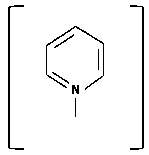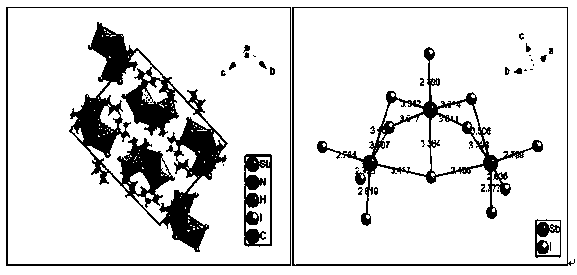Organic-inorganic hybrid material crystal with photoconductive effect and application thereof
A hybrid material, photoconductive technology, applied in the fields of organic chemistry, antimony organic compounds, photovoltaic power generation, etc., can solve the problems of environmental pollution, poor thermal stability and chemical stability of solar cells, etc.
- Summary
- Abstract
- Description
- Claims
- Application Information
AI Technical Summary
Problems solved by technology
Method used
Image
Examples
Embodiment 1
[0039] (1) Add 0.39g of Sb 2 o 3 , 10mL of hydroiodic acid (55%-57%), and 0.39ml of 1-methylpiperidine were added to the inner lining of the reaction kettle in turn, and the inner lining of the reaction kettle was put into the reaction kettle to seal. The chemicals mentioned above Sb 2 o 3 , 1-methylpiperidine can be purchased in general chemical drug stores, and the hydroiodic acid can be purchased in Beijing Yinuokai Technology Co., Ltd. Its advantage is that the color of hydroiodic acid is close to colorless, and its quality is better, which is different from Common yellow and brown hydroiodic acid;
[0040] (2) Put the reaction kettle in an electric blast drying oven, set the temperature parameters as follows: rise from room temperature to 160°C in 3 hours, keep at 160°C for 2 hours, and finally cool down to room temperature in 20 hours;
[0041] (3) Transfer the sample in the reaction kettle in the experiment to the petri dish, suck up the remaining liquid with a plas...
Embodiment 2
[0043] In order to better understand the potential of the present invention applied to optoelectronic devices, the following is the photocurrent test of the material:
[0044] The experimental design and operation are as follows:
[0045] (1) Select a crystal with regular shape, large size and few defects and place it on a non-conductive glass substrate. 6 h 14 N[SbI 4 ] put two silver electrodes on the two ends of the crystal, and heat it on a universal furnace for 10 minutes to make it dry and conduct electricity, forming a simple photodetector, such as Figure 6 shown;
[0046] (2) Place the above-mentioned detector on the TF2000 ferroelectric thin-film probe station, connect the probe to the electrode, and test the current curves of the materials passing through the material under 5V, 10V, and 15V voltages under dark conditions;
[0047] (3) Irradiate 635nm, 445nm, 405nm lasers with a wavelength of 20mw on the surface of the sample, and measure the current curves passi...
Embodiment 3
[0052] Specific application examples
[0053] Such as Figure 7 As shown, it is a schematic diagram of a light-controlled rheostat. Diagram A is the light source with wavelengths of 635nm, 445nm, and 405nm, and 1, 2, and 3 are the switches of light sources with wavelengths of 635nm, 445nm, and 405nm, respectively, to control the opening of different light sources. to include C 6 h 14 N[SbI 4 ] A simple photodetector of materials and electrodes, and B is a metal or other material shell that includes the above-mentioned parts.
[0054] (1) Use a multimeter or other electrical testing instruments to obtain the resistance between the two electrodes under three different wavelength light sources or under dark conditions.
[0055] (2) The electrodes of the device are connected to other devices, and the resistance of the device can be controlled by light sources of different wavelengths to provide different resistance or current signals required for the device.
[0056] Compared...
PUM
 Login to View More
Login to View More Abstract
Description
Claims
Application Information
 Login to View More
Login to View More - R&D
- Intellectual Property
- Life Sciences
- Materials
- Tech Scout
- Unparalleled Data Quality
- Higher Quality Content
- 60% Fewer Hallucinations
Browse by: Latest US Patents, China's latest patents, Technical Efficacy Thesaurus, Application Domain, Technology Topic, Popular Technical Reports.
© 2025 PatSnap. All rights reserved.Legal|Privacy policy|Modern Slavery Act Transparency Statement|Sitemap|About US| Contact US: help@patsnap.com



